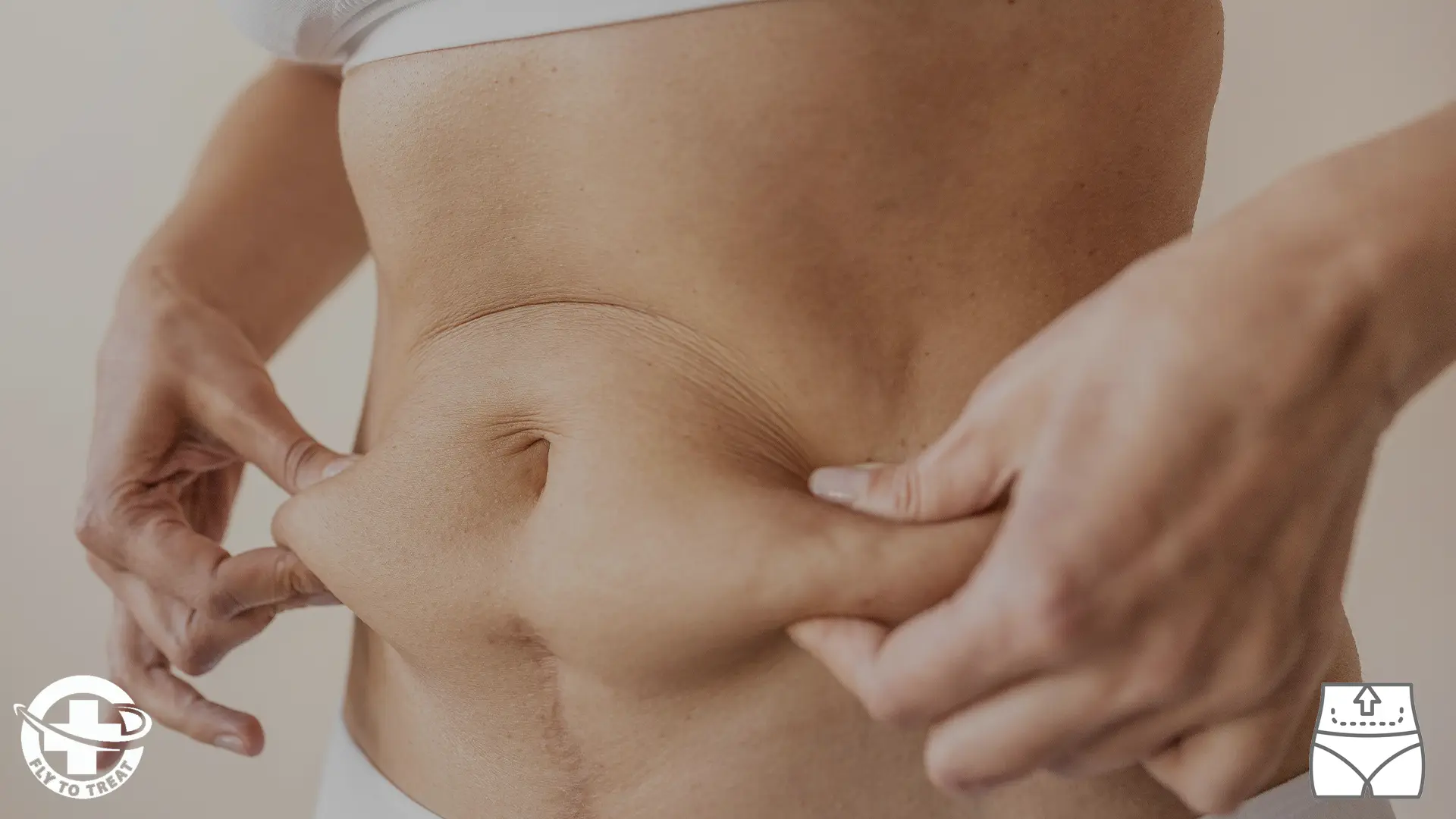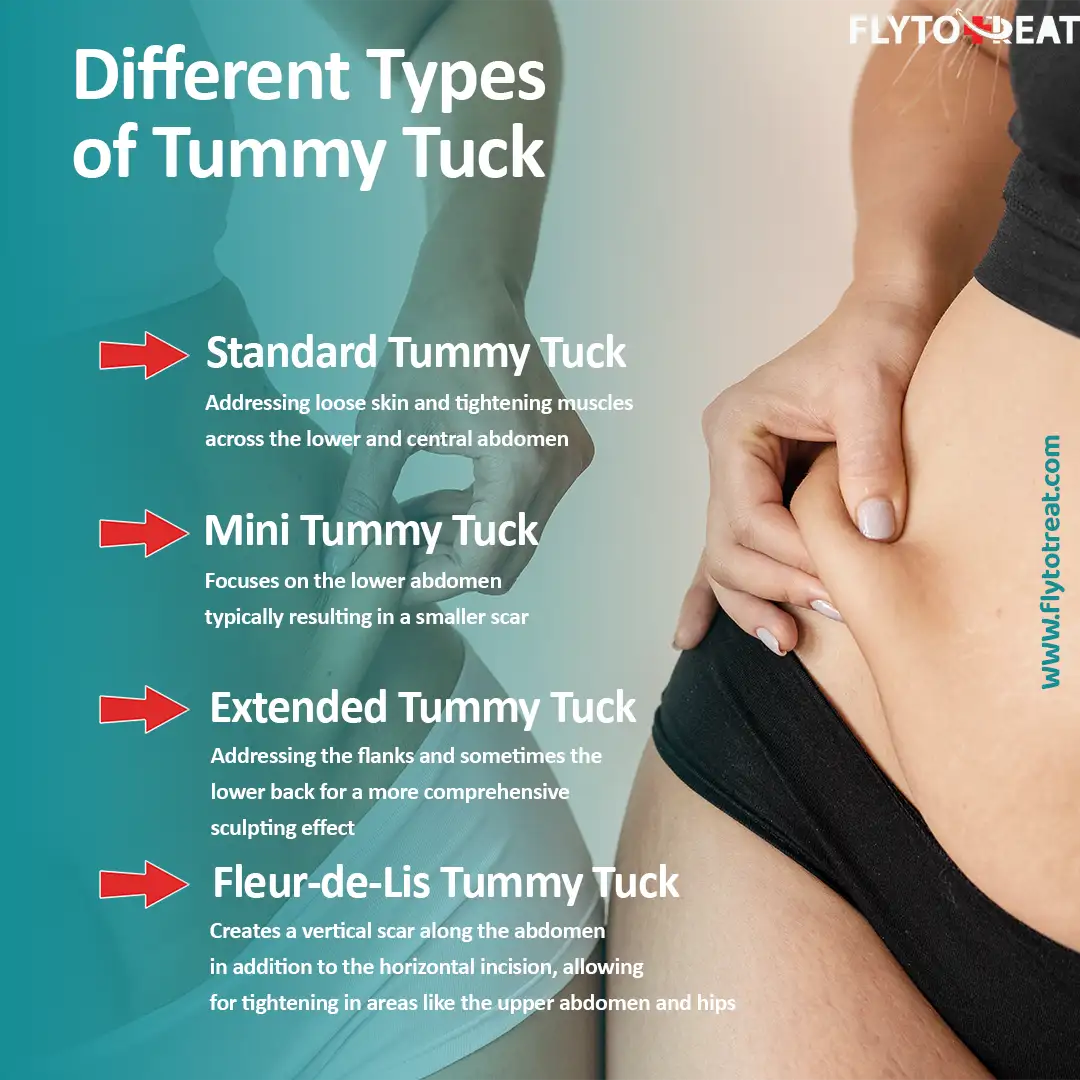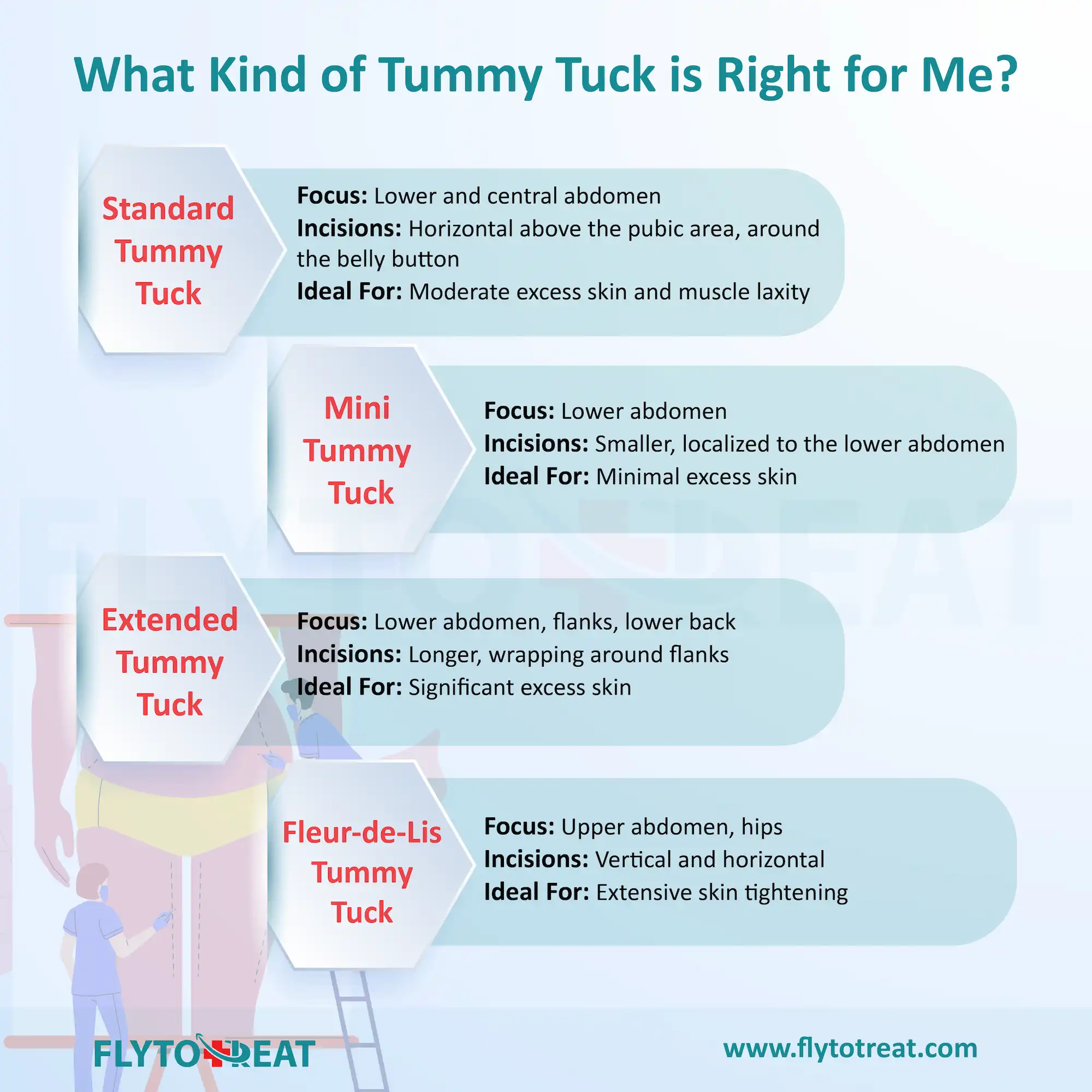
How many different types of tummy tucks are there?
Exploring the different types of tummy tucks can help you understand the range of options available for improving the appearance of your abdomen. FlyToTreat provides insights into each variation, from the less invasive mini tuck to comprehensive 360 tummy tucks, answering key questions such as "What is the newest tummy tuck method?" "Are there different types of tummy tuck?", and "What is a 360 tummy tuck?".
What's a Tummy Tuck?
A tummy tuck, also known as abdominoplasty, is a cosmetic surgery procedure designed to improve the appearance of your abdomen. Here's a quick breakdown of what a tummy tuck can do:
• Targets Loose Skin and Fat: Pregnancy, weight loss, or simply ageing can weaken abdominal muscles and leave excess skin. A tummy tuck removes this excess tissue, creating a smoother and firmer midsection.
• Tightens Muscles: Weak abdominal muscles can contribute to back pain and poor posture. A tummy tuck tightens these muscles, potentially improving core strength and overall comfort.
• Varied Techniques: There are different types of tummy tucks available depending on your specific needs. These can address areas like the lower abdomen, full abdomen, or even the flanks.
A tummy tuck is a major surgery. It's crucial to consult a plastic surgeon to discuss if it's right for you, understand the risks involved, and explore the different tummy tuck types available to achieve your desired results.
How many different types of tummy tucks are there?
Not all tummy tucks are created equal! There are various types of tummy tucks designed to address specific concerns. Here'sHere's a glimpse into the most common variations:
• Standard Tummy Tuck: This is the most common type, addressing loose skin and tightening muscles across the lower and central abdomen.
• Mini Tummy Tuck: Ideal for those with less excess skin, a mini tummy tuck focuses on the lower abdomen, typically resulting in a smaller scar.
• Extended Tummy Tuck: This option goes beyond the standard procedure, addressing the flanks and sometimes the lower back for a more comprehensive sculpting effect.
• Fleur-de-Lis Tummy Tuck: This variation creates a vertical scar along the abdomen in addition to the horizontal incision, allowing for tightening in areas like the upper abdomen and hips.
The best type of tummy tuck for you depends on your individual needs and desired outcome. Consulting with a board-certified plastic surgeon can help you determine the tummy tuck type that best suits your goals.
Types of tummy tuck incisions
While a tummy tuck addresses loose skin and muscle laxity, the types of tummy tuck incisions can vary depending on the chosen procedure. Here's a breakdown of some common incision types:
• Standard Tummy Tuck: This typically involves a horizontal incision across the lower abdomen, just above the pubic area, and a second incision around the belly button for repositioning.
• Mini Tummy Tuck: A shorter incision is made, localized to the lower abdomen, resulting in a less noticeable scar.
• Extended Tummy Tuck: This procedure requires a longer horizontal incision that may extend around the flanks for additional skin removal.
• Fleur-de-Lis Tummy Tuck: This variation combines a horizontal incision with a vertical one extending down the abdomen, allowing for more extensive tightening.
The tummy tuck incision type is chosen to achieve the desired outcome while minimizing scarring. A board-certified plastic surgeon can discuss the incision types associated with different tummy tuck variations and help you determine the approach that best suits your needs.

What is the difference between a full tummy tuck and an extended tummy tuck?
Both full and extended tummy tucks address loose skin and lax muscles but cater to different needs. Here's a breakdown of the key differences between a full tummy tuck and an extended tummy tuck:
• Targeted Areas: A full tummy tuck focuses on the lower and central abdomen, creating a smoother midsection. An extended tummy tuck goes beyond this, addressing the flanks (love handles) and potentially the lower back for a more comprehensive body contour.
• Incision Length: The incision for a full tummy tuck is typically horizontal across the lower abdomen. An extended tummy tuck requires a longer incision that may wrap around the flanks.
• Ideal Candidates: A full tummy tuck is suitable for those with excess skin and lax muscles concentrated in the lower and central abdomen. An extended tummy tuck is ideal for those with significant skin laxity extending to the flanks or lower back.
Consulting a board-certified plastic surgeon is crucial. They can assess your needs and recommend the tummy tuck type, be it full or extended, that best achieves your desired results.
What is the best tummy tuck to get?
There's no single "best" tummy tuck – the ideal choice depends on your unique situation! Here's how to navigate the different tummy tuck types:
• Factors to Consider: Your amount of excess skin, muscle laxity, desired outcome (e.g., flatter tummy, addressed flanks), and body type all influence the tummy tuck variation that best suits you.
• Consultation is Key: A board-certified plastic surgeon can assess your goals and anatomy. They can explain the different types of tummy tucks, like mini, standard, extended, or fleur-de-lis, and recommend the one that best addresses your concerns.
• Focus on Expertise, Not Just Cost: While tummy tuck cost is a consideration, prioritizing an experienced and qualified surgeon is crucial for optimal results and safety.
An individualized approach is key. Schedule consultations with Flytotreat consultants to discuss your goals and choose the tummy tuck type that best aligns with your desired outcome and body.
What is the newest tummy tuck method?
The world of tummy tucks is constantly evolving, with new techniques emerging to refine results. Here's a peek at the latest tummy tuck method gaining attention:
• NaturaTuck: This method focuses on a minimally invasive approach while prioritizing natural-looking results. It emphasizes preserving the integrity of abdominal muscles and achieving smoother contours through precise techniques.
• Focus on Natural Look: Unlike traditional methods solely removing excess tissue, NaturaTuck aims to enhance the body's natural definition, potentially leading to a more aesthetically pleasing outcome.
• Emerging Technique: While NaturaTuck is considered innovative, it's still a developing technique. Consulting with board-certified plastic surgeons familiar with this method can help you understand its potential benefits and suitability for your case.
New technologies are exciting, but careful research is crucial. Discuss the latest tummy tuck methods with experienced surgeons to determine if they align with your goals and ensure they prioritize your safety and well-being.
What is the least invasive tummy tuck?
Traditional tummy tucks require surgery and incisions, which can be a daunting prospect for some people. However, there are alternative options available that are less invasive. For instance, you may want to consider a Mini Tummy Tuck, which involves a smaller incision compared to a full tummy tuck. This approach is particularly suitable if you only have modest amounts of excess skin in the lower abdomen.
It's important to note that not everyone is a candidate for these less invasive options, which is why it's always a good idea to consult with FlytoTreat consultants. They can help you determine the best tummy tuck approach for your unique goals and body composition. By discussing the potential benefits and limitations of each method, they can guide you toward the safest and most effective option for you.
Which Type of Tummy Tuck is Right for You?
There's no one-size-fits-all answer to which type of tummy tuck is right for you. The amount of excess skin, muscle laxity, desired outcome (e.g., flatter tummy, addressed flanks), and body type all influence the tummy tuck variation that best suits you. Through consultation, our consultants can explain the various tummy tuck types like full, mini, extended, or fleur-de-lis and recommend the one that best addresses your concerns.
Prioritize Experience Over Cost. While affordability is a factor, prioritizing a qualified and experienced surgeon is crucial. They can ensure optimal results, minimize risks, and guide you through the recovery process specific to your chosen tummy tuck type.
With a personalized approach and guidance from a qualified professional, you can choose the tummy tuck variation that best aligns with your desired outcome and unique body.

Conclusion
Choosing the right type of tummy tuck depends on individual needs and desired outcomes. FlyToTreat helps clarify the distinctions between tummy tuck types, ensuring you make an informed decision. Whether it's understanding the specific benefits of a tummy tuck or evaluating the less invasive options, this article provides the necessary details to guide your choice, ultimately helping you achieve your aesthetic goals with confidence.
MEDICALLY REVIEWED BY: Dr. Ali Bazazi
AUTHOR: FlytoTreat's team of Authors
07 May 2024 - Updated At: 28 July 2024
Related Articles
Comment




